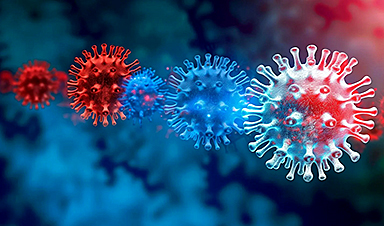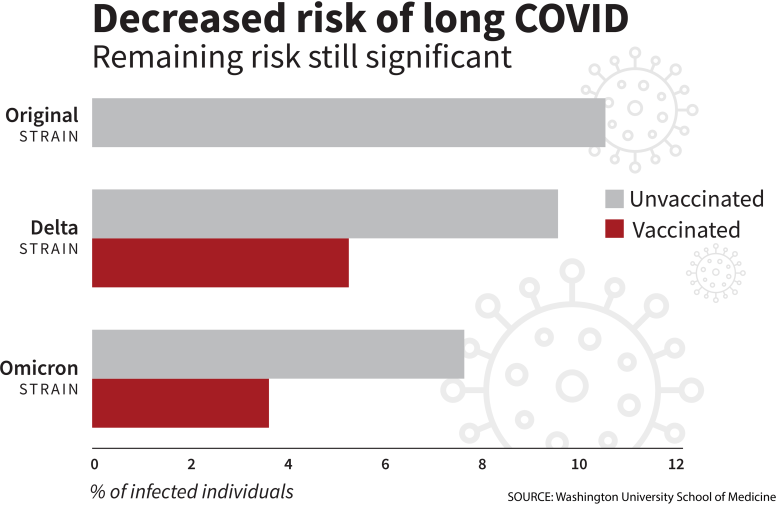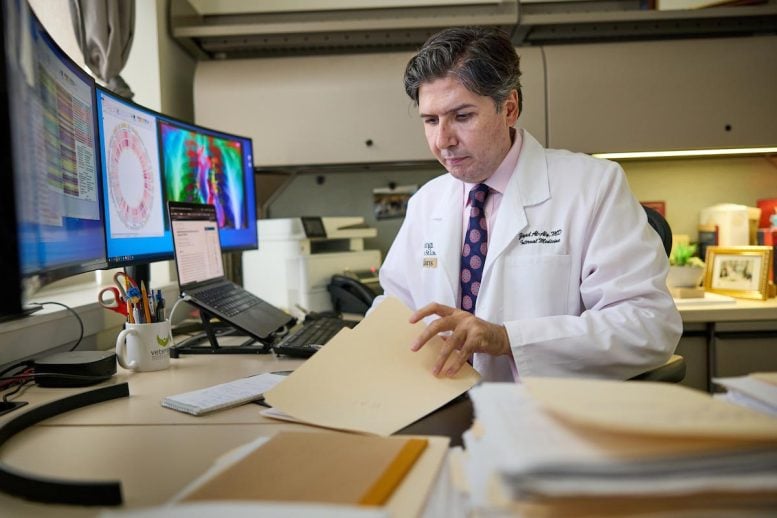Research indicates a significant reduction in long COVID risk, largely due to vaccination and the virus’s evolution.
The study analyzes data from over 441,000 veterans, showing lower rates of long COVID among vaccinated individuals compared to their unvaccinated counterparts across different COVID-19 variants.
Decreased Long COVID Risk and the Role of Vaccination
The risk of developing long COVID has decreased significantly over the course of the COVID-19 pandemic, according to an analysis of data led by Washington University School of Medicine in St. Louis.
Researchers attributed about 70% of the risk reduction to vaccination against COVID-19 and 30% to changes over time, including the SARS-CoV-2 virus’s evolving characteristics and improved detection and management of COVID-19.
The research is published July 17 in The New England Journal of Medicine.
“The research on declining rates of long COVID marks the rare occasion when I have good news to report regarding this virus,” said the study’s senior author, Ziyad Al-Aly, MD, a Washington University clinical epidemiologist and global leader in COVID-19 research. “The findings also show the positive effects of getting vaccinated.”
The risk of long COVID has declined over the course of the pandemic, although it remains a persistent threat. Researchers from Washington University School of Medicine in St. Louis identified vaccination as a primary factor in reducing the risk of long COVID. Credit: Sara
Impact of Long COVID Across Organ Systems
Long COVID encompasses the lingering and debilitating effects on health experienced by about 10% of people who have been infected with COVID-19. To date, the World Health Organization has documented more than 775 million cases of COVID-19.
In more than 30 high-profile studies, Al-Aly has detailed the virus’s indiscriminate, long-term health impacts across nearly all organ systems affecting the heart, brain, kidneys and gastrointestinal (GI) tract.
Although his latest findings sound more reassuring than previous studies, Al-Aly tempered the good news. “Long COVID is not over,” said the nephrologist, who treats patients at Washington University-affiliated John J. Cochran Veterans Hospital in St. Louis. “We cannot let our guard down. This includes getting annual COVID vaccinations, because they are the key to suppressing long COVID risk. If we abandon vaccinations, the risk is likely to increase.”
Analyzing Long COVID Trends and Variants
Since the pandemic’s beginning, Al-Aly has dedicated himself to analyzing long COVID with the aim of helping the public make informed health choices; supporting scientists in generating research-backed recommendations on prevention and treatment; and enabling politicians to make educated decisions regarding funding and public policies. Al-Aly’s latest study builds on this body of work by examining the virus’s variants and overall evolution.
To do this, Al-Aly and his team analyzed millions of de-identified medical records in a database maintained by the U.S. Department of Veterans Affairs, the nation’s largest integrated health-care system. The study included 441,583 veterans with SARS-CoV-2 infections and more than 4.7 million uninfected veterans, from March 1, 2020, through Jan. 31, 2022.
Patients included people of diverse ages, races and sexes; statistical modeling ensured parity in representation.
The researchers divided the veterans into five groups: unvaccinated COVID-19 sufferers who acquired the original strain in 2020; the delta variant in 2021; and the omicron variant in 2022. The other two groups included vaccinated people who had the delta variant, and vaccinated people with omicron. No vaccines existed while the original strain circulated.
Since the pandemic’s beginning, Ziyad Al-Aly, MD, a clinical epidemiologist at Washington University School of Medicine in St. Louis, has dedicated himself to analyzing long COVID with the aim of helping the public make informed health choices and educating scientists and policymakers on prevention and treatment. Al-Aly’s latest study in The New England Journal of Medicine builds on his research by examining the virus’s variants and overall evolution. Credit: Matt Miller
Vaccination Efficacy and Continuing Challenges
The team estimated rates of long COVID one-year postinfection for each of the five groups.
Unsurprisingly, the rate of long COVID was the highest among those with the original strain, Al-Aly said, with 10.4% of those who had infections that developed into long COVID.
That declined to 9.5% among those in the unvaccinated groups during the delta era and 7.7% during omicron.
Among the vaccinated, the rate of long COVID during delta was 5.3% and 3.5% during omicron.
“You can see a clear and significant difference in risk during the delta and omicron eras between the vaccinated and unvaccinated,” said Al-Aly, who is also director of the Clinical Epidemiology Center at the VA St. Louis Health Care System and head of the research and development service. “So, if people think COVID is no big deal and decide to forgo vaccinations, they’re essentially doubling their risk of developing long COVID.”
Al-Aly also emphasized that even with the overall decline, the lowest rate — 3.5% — remains a substantial risk. “That’s three to four vaccinated individuals out of 100 getting long COVID,” he said. “Multiplied by the large numbers of people who continue to get infected and reinfected, it’s a lot of people. This remaining risk is not trivial. It will continue to add an already staggering health problem facing people across the world.”
Evolution of the Virus and Its Diverse Impacts
Since the pandemic’s beginning, Ziyad Al-Aly, MD, a clinical epidemiologist at Washington University School of Medicine in St. Louis, has dedicated himself to analyzing long COVID with the aim of helping the public make informed health choices and educating scientists and policymakers on prevention and treatment. Al-Aly’s latest study in The New England Journal of Medicine builds on his research by examining the virus’s variants and overall evolution.
Another notable finding offers clues to the virus’s evolution, Al-Aly added. While analyzing the risk among all people infected with COVID-19 during the omicron era of 2022, the likelihood of heart, brain, kidney and lung problems declined. In contrast, diseases and illnesses associated with metabolic function and the GI system increased.
“People tend to think of SARS-CoV-2 as a homogeneous virus,” Al-Aly said. “But each variant has its own fingerprint. The original virus hit the respiratory system hard. Omicron targeted metabolic and GI issues. It’s important because while the risk of long COVID is quantitatively lower, a person can be at a higher risk of developing an illness based on the part of the body that the COVID variant targets.
“It’s really good news that the risk has declined,” he said. “But we know millions of people already have long COVID, and millions more will continue to get long COVID. We need to double down on our efforts to understand it so we can prevent suffering and treat affected individuals.”
Reference: “Postacute Sequelae of SARS-CoV-2 Infection in the Pre-Delta, Delta, and Omicron Eras” by Yan Xie, Taeyoung Choi and Ziyad Al-Aly, 16 July 2024, New England Journal of Medicine.
DOI: 10.1056/NEJMoa2403211
This research was funded by the U.S. Department of Veterans Affairs.
News
Nano-Enhanced Hydrogel Strategies for Cartilage Repair
A recent article in Engineering describes the development of a protein-based nanocomposite hydrogel designed to deliver two therapeutic agents—dexamethasone (Dex) and kartogenin (KGN)—to support cartilage repair. The hydrogel is engineered to modulate immune responses and promote [...]
New Cancer Drug Blocks Tumors Without Debilitating Side Effects
A new drug targets RAS-PI3Kα pathways without harmful side effects. It was developed using high-performance computing and AI. A new cancer drug candidate, developed through a collaboration between Lawrence Livermore National Laboratory (LLNL), BridgeBio Oncology [...]
Scientists Are Pretty Close to Replicating the First Thing That Ever Lived
For 400 million years, a leading hypothesis claims, Earth was an “RNA World,” meaning that life must’ve first replicated from RNA before the arrival of proteins and DNA. Unfortunately, scientists have failed to find [...]
Why ‘Peniaphobia’ Is Exploding Among Young People (And Why We Should Be Concerned)
An insidious illness is taking hold among a growing proportion of young people. Little known to the general public, peniaphobia—the fear of becoming poor—is gaining ground among teens and young adults. Discover the causes [...]
Team finds flawed data in recent study relevant to coronavirus antiviral development
The COVID pandemic illustrated how urgently we need antiviral medications capable of treating coronavirus infections. To aid this effort, researchers quickly homed in on part of SARS-CoV-2's molecular structure known as the NiRAN domain—an [...]
Drug-Coated Neural Implants Reduce Immune Rejection
Summary: A new study shows that coating neural prosthetic implants with the anti-inflammatory drug dexamethasone helps reduce the body’s immune response and scar tissue formation. This strategy enhances the long-term performance and stability of electrodes [...]
Scientists discover cancer-fighting bacteria that ‘soak up’ forever chemicals in the body
A family of healthy bacteria may help 'soak up' toxic forever chemicals in the body, warding off their cancerous effects. Forever chemicals, also known as PFAS (per- and polyfluoroalkyl substances), are toxic chemicals that [...]
Johns Hopkins Researchers Uncover a New Way To Kill Cancer Cells
A new study reveals that blocking ribosomal RNA production rewires cancer cell behavior and could help treat genetically unstable tumors. Researchers at the Johns Hopkins Kimmel Cancer Center and the Department of Radiation Oncology and Molecular [...]
AI matches doctors in mapping lung tumors for radiation therapy
In radiation therapy, precision can save lives. Oncologists must carefully map the size and location of a tumor before delivering high-dose radiation to destroy cancer cells while sparing healthy tissue. But this process, called [...]
Scientists Finally “See” Key Protein That Controls Inflammation
Researchers used advanced microscopy to uncover important protein structures. For the first time, two important protein structures in the human body are being visualized, thanks in part to cutting-edge technology at the University of [...]
AI tool detects 9 types of dementia from a single brain scan
Mayo Clinic researchers have developed a new artificial intelligence (AI) tool that helps clinicians identify brain activity patterns linked to nine types of dementia, including Alzheimer's disease, using a single, widely available scan—a transformative [...]
Is plastic packaging putting more than just food on your plate?
New research reveals that common food packaging and utensils can shed microscopic plastics into our food, prompting urgent calls for stricter testing and updated regulations to protect public health. Beyond microplastics: The analysis intentionally [...]
Aging Spreads Through the Bloodstream
Summary: New research reveals that aging isn’t just a local cellular process—it can spread throughout the body via the bloodstream. A redox-sensitive protein called ReHMGB1, secreted by senescent cells, was found to trigger aging features [...]
AI and nanomedicine find rare biomarkers for prostrate cancer and atherosclerosis
Imagine a stadium packed with 75,000 fans, all wearing green and white jerseys—except one person in a solid green shirt. Finding that person would be tough. That's how hard it is for scientists to [...]
Are Pesticides Breeding the Next Pandemic? Experts Warn of Fungal Superbugs
Fungicides used in agriculture have been linked to an increase in resistance to antifungal drugs in both humans and animals. Fungal infections are on the rise, and two UC Davis infectious disease experts, Dr. George Thompson [...]
Scientists Crack the 500-Million-Year-Old Code That Controls Your Immune System
A collaborative team from Penn Medicine and Penn Engineering has uncovered the mathematical principles behind a 500-million-year-old protein network that determines whether foreign materials are recognized as friend or foe. How does your body [...]























